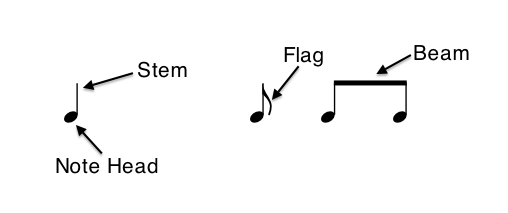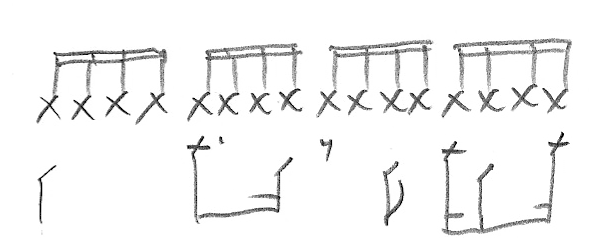How To Write Drum Set Notation
How to Write Drum Set Music Notation
Knowing how to write drum notation gives you an advantage as a student and a performer. You will often find it useful to write a drum rhythm or fill that you want to remember.

The note head shown above is a note ball. It is not a perfect circle; it’s slightly oval. This is what notes normally look like.
Drum notation is unique because it uses note-head symbols in addition to the regular note ball. The most common are “X” note heads which are used for cymbals. Other note heads are diamonds, triangles, and slashes.
Other Note Heads

Drum notation is also unique because the lines and spaces of the staff do not represent pitches; they represent drums. This is indicated by using a neutral clef, also called a percussion clef.
Neutral Clef

The most common clefs used in non-drum music are the treble clef and bass clef.

treble clef

bass clef
See Clef on Wikipedia for a great article.
When you use a neutral clef, the lines and spaces of the staff do not represent specific pitches. To show which line or space designates which drum or cymbal, use a legend, like this:
Drum Legend

Don’t include instruments in the legend that are not used. If your drum set has three tom-toms, but only two are played, include only two toms in the legend. When creating a drum legend, try to assign the instruments to lines or spaces that will make the drum music easy to read. In the music examples below, it’s easy to tell the difference between bass drum and snare drum because they are not on adjacent lines of the staff.
An alternative to a Legend is to identify the instruments at the beginning of the music, like this:

Use a three-line staff if only three instruments are needed.

Use a one-line staff if only one instrument is needed.

There is no standard drum set legend, but here are some general guidelines.
-

Hi-Hat with Foot
Cymbals usually go near the top line, except Hi-Hat when played with the foot, which usually goes below the bottom line.
- Bass drum usually goes on the bottom space.
- Snare drum usually goes on the third space from bottom.
- Tom-toms usually go on lines or spaces in order of their size.
This Drum Legend from above is common for a 5-piece drum set.

HiHats and cymbals can have additional notations.

When I write drum parts, I often use slashes instead of note balls to make writing faster. I don’t always draw staff lines or time signatures.
Write Drum Set Music – Staff
When writing drum set rhythms without a staff, I’ll put a ledger line through the snare drum note to make it easy to identify.

Make notes for yourself when it’s unclear which drums should be used.

When writing notation for someone else to read, the most important thing is to make it clearly understood what is to be played. If needed include notes about:
- Time Signatures
- Dynamics
- Tempo
The best way to become good at writing drum notation is to do it. A good way to begin is to try writing the notation from any page in your drum lesson books. Later, you’ll be able to listen to a song and write out the drum part the drummer is playing. You can use regular lined notebook paper if you don’t have staff paper. You can also easily find staff paper online to print off.
Drum Notation Help
Get in touch if you have any questions. -Jamison


I realized the drum clefs ( or percussion clefs ) is not the same as piano clefs.
Thanks for stopping by!
Thanks for the knowledge.am a learner and needs more of drum staff in a simple way I can understand
Prince Favour, is there anything I can clarify?
I’m a composer who is writing for drum kit for the first time for a theatrical work. Thank you for the helpful guide.
Hi David, thanks for the note. I would love to see what you’re working on. You can email a link if you have a site. Thanks! Jamison
jamison@sheboygandrums.com
Playing the drum would be so much fun. It’s nice to feel every beat that it produce, a beautifully patterned rhythm. I’ve played the piano, guitar, and violin. This instrument is quite different. Thank you for this post. Oh! if it would interest you, please check out this article about the treble clef:
Let me know what you think.
Thanks,
Stephanie
Drum rhythms are definitely something one can feel, not just the body movements used to play the instruments, but the powerful sound waves they produce, especially with larger drums. Evelyn Glennie is a percussionist who, because of her deafness, uses other parts of her body to feel and hear the instruments she plays.
The piano also creates powerful vibrations that are part of the playing experience. The physical feeling of music is part of the listening experience for performers and listeners alike.
thanks.